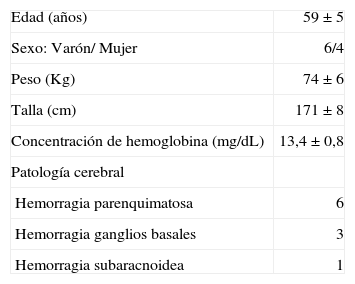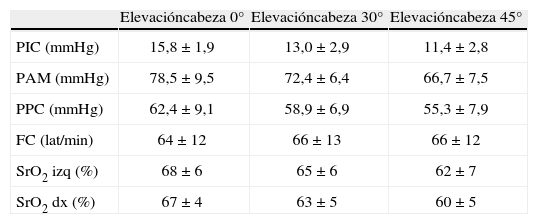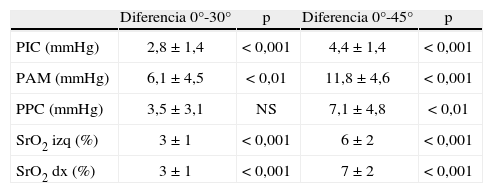Estudiar los efectos de la posición semisentada con la cabecera a 30 y 45 grados sobre la dinámica cerebral y oxigenación cerebral regional en pacientes con hemorragia cerebral.
Pacientes y métodosEstudio prospectivo sobre 10 pacientes con hemorragia cerebral, sometidos a sedoanalgesia y ventilación mecánica. Se recogieron los valores de PIC, presión arterial media (PAM), presión de perfusión cerebral (PPC) y oximetría cerebral regional por infrarrojos (SrO2) con la cabeza en posición horizontal (0°) y elevada 30° y 45°, tras un periodo de estabilización de 5minutos.
ResultadosLa PIC disminuyó significativamente en las posiciones de 30° y 45° con respecto a los valores en posición horizontal (disminuyeron 2,8±1,4mmHg y 4,4±1,4mmHg, respectivamente). La PPC descendió ligeramente a 30° de elevación de la cabeza (3,5±3,1mmHg, p=0,048), siendo la reducción más importante a 45° (7,1±4,8mmHg, p < 0,01). Asimismo, la mayor reducción de la PAM se registró con la cabeza elevada 45° (11,8±4,6mmHg, p < 0,001). La SrO2 se redujo al elevar la cabeza 30° y 45°, existiendo la mayor diferencia cuando la cabeza se elevó a 45° (7%±2% p < 0,001). Una correlación moderada fue observada entre los valores de PPC y los cambios de la SrO2(r2=0,45, p < 0,001).
ConclusiónLa elevación de la cabeza produce una disminución significativa de la PIC y la PPC en pacientes con hemorragia cerebral. Asimismo, la elevación de la cabeza disminuye la SrO2, dependiendo los cambios de la SrO2 del grado de elevación de la cabeza.
To study the effects on cerebral dynamics and regional oxygenation (rSO2) of the semi-sitting position, with the head at either 30° or 45°, in surgery for cerebral hemorrhage.
Patients and methodsWe performed a prospective study of 10 patients undergoing surgery for cerebral hemorrhage under sedation and analgesia and with mechanical ventilation. Intracranial pressure (ICP), mean arterial pressure (MAP), cerebral perfusion pressure (CPP), and rSO2 measured using near-infrared spectroscopy were recorded with the head in the supine position (0°) and elevated to an angle of 30° and then 45°, following a stabilization period of 5minutes.
ResultsMean (SD) ICP values were significantly lower in both semi-sitting positions than in the supine position: 2.8 (1.4)mm Hg lower at 30° and 4.4 (1.4)mm Hg lower at 45°. Mean CPP values were fell slightly when the head was elevated to 30° (3.5 [3.1]mm Hg, P=.048); a greater reduction was achieved when the head was elevated 45° (7.1 [4.8]mm Hg, P<.01). The greatest reduction in mean MAP values also occurred with the head elevated to 45° (11.8 [4.6]mm Hg, P<.001). Mean rSO2 values fell when the head was elevated to 30° and 45°; the greatest reduction occurred when the head was elevated to 45° (7% [2%], P<.001). There was a moderate correlation between CPP values and changes in rSO2 (r2=0.45, P<.001).
ConclusionHead elevation significantly reduces ICP and CPP in patients with cerebral hemorrhage. Head elevation also reduces rSO2, to a greater or lesser extent depending on the degree to which the head is elevated.
Artículo
Comprando el artículo el PDF del mismo podrá ser descargado
Precio 19,34 €
Comprar ahora











